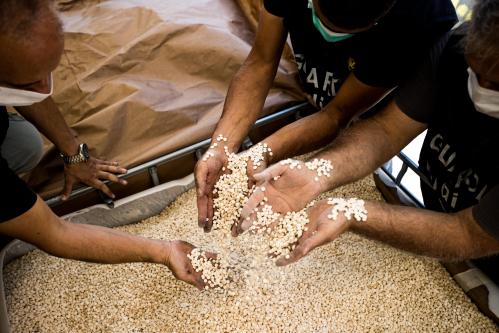After the transfer of sovereignty in Iraq on June 28, the American media’s attention reverted back home to political conventions and other developments.
Meanwhile, the situation in Iraq went from relatively bad to relatively worse. There is still hope for success—but the vision of a thriving, peaceful democracy seems increasingly remote. America’s exit strategy may now be to keep a lid on the insurgency long enough to train Iraqis to handle the war themselves so that our troops can go home in two or three years, even though much of their mission may well remain undone.
There is good news: Iraq’s new government remains relatively popular among its citizens. The lowering of the U.S. profile in the country has taken some of the edge off the anti-Americanism that appears to have increasingly fueled the insurgency over the past year or so. And hardened by decades of Baathist misrule, Iraqis remain glad for Saddam’s ouster and guardedly optimistic for their future.
But the economy is improving only slowly, despite the supposed availability of more than $20 billion in U.S. aid and high oil prices. Unemployment appears to remain in the 30%-40% range; peak electricity production is up, but hours of service per day are down; the water and sewage infrastructure is improving slowly; health care facilities remain under-equipped; better telephone service and more accurate textbooks in schools cannot compensate for the general mediocrity of living conditions, which on balance are about where they were in Saddam’s latter days.
And security, alas, is even worse than the economy. Not only do the car bombings and gunfights continue, but the rate of routine crimes perpetrated against Iraqi citizens remains among the very highest in the region. Insurgent attacks on U.S. forces are up 20% since the spring and 100% since last winter; U.S. Central Command’s estimate of the number of hardened resistance fighters is also up by a factor of four since early in the year. American fatalities in August were at their fourth-highest monthly total since Saddam fell, and the number of American wounded that month was its highest ever. And despite the relatively successful outcome of the battle against Moktada al-Sadr’s Mahdi Army in Najaf last month, several key Iraqi cities in the Sunni Triangle remain ungovernable and havens for terrorists and insurgents.
1,005
U.S. troop fatalities in Iraq
7,025
U.S. troops wounded in action, as of September 8
206,000
Iraqi security forces as of August 2004
53%
Proportion of Iraqi security forces who have been partially or fully trained
11,400-22,200
Estimated number of Iraqi civilians killed as a result of violence from war and crime between the declared end of major combat operations on April 30, 2003 and July 30, 2004
710
Iraqi police killed since May 2003
22,000
Estimated number of Iraqi insurgents
2,700
Number of insurgent attacks on coalition forces during the month of August
$500
Reward offered in December 2003 for attempted attacks on U.S. troops
$3,000
Reward offered by insurgents for successful attacks on U.S. troops
30%-40%
Iraqi unemployment rate in August
50%-60%
Iraqi unemployment rate one year earlier
$55,259,000,000
Estimated amount needed for Iraqi reconstruction from 2004-2007
$58,250,000,000
Funds available, obligated or disbursed for Iraq reconstruction as of April
46.5%
Proportion of Iraqis polled last month who said their life has gotten better since the fall of the Baath regime
58%
Proportion of Iraqis who said that democracy is either “very” or “somewhat” likely to succeed in Iraq



Commentary
Op-edIraq: A Quantitative Assessment
September 17, 2004